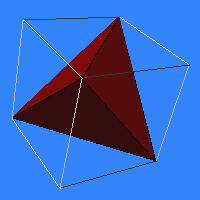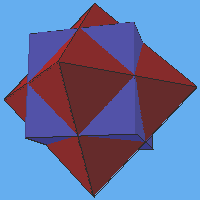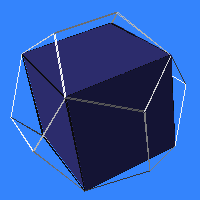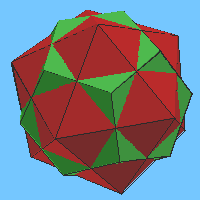Platonic Relationships
Exercise: Get to know the five Platonic
solids and the relationships between them. Start by counting the number
of faces, edges, and vertices found in each of these five models. Make
a table with the fifteen answers and notice that only six different numbers
appear in the fifteen slots.
Answer:
faces edges vertices
tetrahedron 4 6 4
cube 6 12 8
octahedron 8 12 6
dodecahedron 12 30 20
icosahedron 20 30 12
Observe that every number which appears somewhere in this table appears
at least twice. These are not mere numerical coincidences.
Relationships Between the Platonic Solids
Every time that a number shows up in two different places in the above
table there is a significant relationship to be understood. Stop and savor
each of these connections, studying the accompanying figure until it is
clear:
6 edges in a tetrahedron = 6 faces in a cube:
 This
is a consequence of the fact that a
tetrahedron can be inscribed in a cube. This establishes a one-to-one
relationship between faces of the cube and edges of the tetrahedron, so
there must be the same number of each. Each of the 6 edges of the
tetrahedron shows up as one of the diagonals of one of the 6 faces
of the cube.
This
is a consequence of the fact that a
tetrahedron can be inscribed in a cube. This establishes a one-to-one
relationship between faces of the cube and edges of the tetrahedron, so
there must be the same number of each. Each of the 6 edges of the
tetrahedron shows up as one of the diagonals of one of the 6 faces
of the cube.
Note that there are two different ways in which 4 of the 8 cube vertices
could be chosen as the tetrahedron vertices.
4 faces in a tetrahedron = 4 vertices in a tetrahedron:
This follows from the fact that in the tetrahedron,
every face is directly opposite a vertex, so there is a one-to-one relation
between faces and vertices. If there are 4 of one, there must be
4 of the other. In the other four Platonic solids, faces are opposite
faces and vertices are opposite vertices, so the number of faces does not
need to equal the number of vertices. In other words, only the tetrahedron
has the property that you can rest it face-down on a table and not
have a face on top; instead, a vertex is on top.
 Another
way of characterizing the same property is that a
tetrahedron can be superimposed with a copy of itself facing in the opposite
direction. The two tetrahedra have a common center, so the 4
vertices of one tetrahedron are centered in the 4 faces of the other
tetrahedron. No other Platonic solid has this property. When two tetrahedra
are combined in this manner, the result is called the compound of two
tetrahedra, or the stella octangula, Kepler's Latin term for
eight-pointed star.
Another
way of characterizing the same property is that a
tetrahedron can be superimposed with a copy of itself facing in the opposite
direction. The two tetrahedra have a common center, so the 4
vertices of one tetrahedron are centered in the 4 faces of the other
tetrahedron. No other Platonic solid has this property. When two tetrahedra
are combined in this manner, the result is called the compound of two
tetrahedra, or the stella octangula, Kepler's Latin term for
eight-pointed star.
6 edges in a tetrahedron = 6 vertices in an octahedron:
This is a consequence of the fact that an
octahedron can be inscribed in a tetrahedron. The 6 edge-midpoints
of the tetrahedron are the 6 vertices of the octahedron. (The octahedron
in this image is the intersection of the two components of the stella octangula.)
6 faces in a cube = 6 vertices in an octahedron,
8 vertices in a cube = 8 faces in an octahedron,
12 edges in a cube = 12 edges in an octahedron:
 All
three of these numerical identities can be seen if we examine a compound
of a cube and an octahedron. In the center of each of the 6
faces in the cube is one of the 6 vertices of the octahedron. In
the center of each of the 8 faces of the octahedron is one of the
8 vertices of the cube. Also, the 12 edges of the cube and
the 12 edges of the octahedron bisect each other at right angles.
This special triple relationship between the cube and the octahedron is
called duality, and has many important consequences.
All
three of these numerical identities can be seen if we examine a compound
of a cube and an octahedron. In the center of each of the 6
faces in the cube is one of the 6 vertices of the octahedron. In
the center of each of the 8 faces of the octahedron is one of the
8 vertices of the cube. Also, the 12 edges of the cube and
the 12 edges of the octahedron bisect each other at right angles.
This special triple relationship between the cube and the octahedron is
called duality, and has many important consequences.
12 edges in a cube = 12 faces in a dodecahedron:
 This
is a consequence of the beautiful fact that a
cube can be inscribed in a dodecahedron. Note that each of the 12
faces of the dodecahedron contains one of the 12 edges of the cube.
The cube's edges are diagonals of the pentagons. This figure also suggests
how one can build a dodecahedron by adding six pyramid-like bumps to the
six faces of the cube.
This
is a consequence of the beautiful fact that a
cube can be inscribed in a dodecahedron. Note that each of the 12
faces of the dodecahedron contains one of the 12 edges of the cube.
The cube's edges are diagonals of the pentagons. This figure also suggests
how one can build a dodecahedron by adding six pyramid-like bumps to the
six faces of the cube.
12 edges in an octahedron = 12 vertices in an icosahedron:
Another 12=12 equivalence, this one follows from a construction
in which an icosahedron is
inscribed in an octahedron. Each of the 12 edges of the octahedron
contains one of the 12 vertices of the icosahedron. Incidentally,
the edges of the octahedron are divided according to the golden
ratio.
12 faces of dodecahedron = 12 vertices of icosahedron,
20 vertices of dodecahedron = 20 faces of icosahedron,
30 edges of dodecahedron = 30 edges of icosahedron:
 Again,
a triple relationship of duality holds between
two polyhedra. These three numerical identities can be clearly seen if
we examine a compound
of a dodecahedron and an icosahedron. In the center of each of the
12 faces of the dodecahedron is one of the 12 vertices of
the icosahedron. And, in the center of each of the 20 faces of the
icosahedron is one of the 20 vertices of the dodecahedron. Also,
the 30 edges of the dodecahedron and the 30 edges of the
icosahedron cross each other at right angles at their midpoints.
Again,
a triple relationship of duality holds between
two polyhedra. These three numerical identities can be clearly seen if
we examine a compound
of a dodecahedron and an icosahedron. In the center of each of the
12 faces of the dodecahedron is one of the 12 vertices of
the icosahedron. And, in the center of each of the 20 faces of the
icosahedron is one of the 20 vertices of the dodecahedron. Also,
the 30 edges of the dodecahedron and the 30 edges of the
icosahedron cross each other at right angles at their midpoints.
The last two may be the toughest. If you've followed the above, work
on these as exercises:
12 edges in a octahedron = 12 faces in a dodecahedron:
Exercise: Figure out how to construct a model of an octahedron
inscribed in a dodecahedron. Study
it to directly see a one-to-one relationship between octahedron edges and
dodecahedron faces.
Hint: Combine this
idea and this idea,
then erase the cube. The octahedron vertices will lie on the midpoints
of six of the dodecahedron edges.
Answer: Look at the
answer face-on and see how one octahedron edge lies directly behind
each dodecahedron face.
12 edges in an cube = 12 vertices in an icosahedron:
Exercise: Figure out how to construct a model of an icosahedron
inscribed in a cube.
Hint: Combine this
idea and this
idea, then erase the dodecahedron and enlarge the cube.
Answer: Answer.
Now it is time to observe a deeper relationship hidden in all five rows
of the table at the top of this page. For any given polyhedron, let V
be the number of vertices, let E be the number of edges, and let
F be the number of faces.
Exercise: From the entries in the table, compute F-E+V for
each of the five Platonic solids.
Answer: Notice a simple consistent answer.
 This
is a consequence of the fact that a
tetrahedron can be inscribed in a cube. This establishes a one-to-one
relationship between faces of the cube and edges of the tetrahedron, so
there must be the same number of each. Each of the 6 edges of the
tetrahedron shows up as one of the diagonals of one of the 6 faces
of the cube.
This
is a consequence of the fact that a
tetrahedron can be inscribed in a cube. This establishes a one-to-one
relationship between faces of the cube and edges of the tetrahedron, so
there must be the same number of each. Each of the 6 edges of the
tetrahedron shows up as one of the diagonals of one of the 6 faces
of the cube. 


